Theoretical Basis and Technical Method of Permeability Enhancement of Tectonic Coal Seam by High Intensity Acoustic Wave In Situ
Abstract
:1. Introduction
2. Theoretical Basis of High-Strength Acoustic Penetration of Tectonic Coal Seam
2.1. The Attenuation Law of Shock Wave to High-Strength Sound Wave
2.2. Principle of High-Strength Acoustic Wave Coal Seam Penetration
- (1)
- Technical conditions of high-strength acoustic wave penetration of coal seams
- (2)
- Mechanical basis of the permeable structural coal seam
- (3)
- Effective penetration increase range
- (4)
- The relationship between acoustic wave intensity and coal seam crack extended stress
2.3. Simulation Experiment of Coal Seam with High-Strength Acoustic Wave Excitation and Permeability Enhancement
2.4. Field Test of High-Strength Sound Wave Increases the Coal Seam
3. Implementation Method of High-Strength Sound Wave Increasing Coal Seam
3.1. In-Situ Generating Method of High-Strength Sound Waves
3.2. Implementation Scheme Design
- (1)
- Design parameters
- (2)
- Design of perforhole arrangement
- (3)
- Design of horizontal hole operation layout in heading face
- (4)
- Design of the channel roof drilling operation layout scheme
3.3. Prediction of the Effective Action Range of the High-Strength Sound Wave
4. Conclusions
- Based on theoretical analysis, experimental results and a field test, the theoretical and technical parameters of a high-intensity acoustic wave used to increase the penetration of coal seams are proposed. The method of impact and conversion into a high-strength sound wave in the roof and bottom plate solves the problem of hole forming in the structural coal seam, and it avoids the problem of the outburst of coal and gas caused by the impact of the structural coal seam.
- The implementation method is proposed to implement the impact at the top and bottom of the penetration hole and use the attenuation effect of the top and bottom to generate high intensity acoustic waves to increase coal seam penetration. That is, in the top or bottom construction drilling, the strong shock wave cracks and tears the roof and bottom plate to communicate the coal seam. The top and bottom plate is used to convert the shock wave into a high-strength sound wave into the structural coal seam, and the top and bottom impact drilling is also used as a gas extraction drilling.
- According to the output parameters of the existing shock wave equipment to produce peak 200 MPa, the effective range of a strong impact to crack and tear typical sandstone, and the parameters and effective range of strong shock wave evolution into a high-strength sound wave are estimated to provide a basis for the design of the drilling position.
- Based on theoretical analysis and test results, the implementation method is not limited to controllable shock wave technology, but can also use the existing deep hole pre-crack loose blasting, carbon dioxide cracking as sound source. However, relevant operational parameters need to be re-estimated and the safety management of the roof should be ensured.
Author Contributions
Funding
Conflicts of Interest
References
- Li, M.; Jiang, B.; Miao, Q.; Wang, G.; You, Z.; Lan, F. Multi-phase tectonic movements and their controls on coalbed methane: A case study of No. 9 coal seam from Eastern Yunnan, SW China. Energies 2020, 13, 6003. [Google Scholar] [CrossRef]
- Lei, C.; Liu, C. Reformed pattern of coal reservoirs in reformed coal basins and effect on favorable blocks of coalbed gas in the North China craton. Coal Geol. Explor. 2004, 32, 20–23. [Google Scholar]
- Kechang, X. Research on Unconventional Natural Gas Development and Utilization Strategy in China; Science Press: Beijing, China, 2014. [Google Scholar]
- Cheng, Y.; Lei, Y. Causality between tectonic coal and coal and gas outbursts. J. China Coal Soc. 2021, 46, 180–196. [Google Scholar]
- Jasinge, D.; Ranjith, P.G.; Choi, S.K. Effects of effective stress changes on permeability of latrobe valley brown coal. Fuel 2011, 90, 1292–1300. [Google Scholar] [CrossRef]
- Zhang, Z.; Qin, Y.; Wang, G.; Sun, H.; You, Z.; Jin, J.; Yang, Z. Evaluation of coal body structures and their distributions by geophysical logging methods: Case study in the Laochang block, eastern Yunnan, China. Nat. Resour. Res. 2021, 30, 2225–2239. [Google Scholar] [CrossRef]
- Zhang, Z.; Qin, Y.; Yi, T.; You, Z.; Yang, Z. Pore structure characteristics of coal and their geological controlling factors in the eastern Yunnan and western Guizhou, China. ACS Omega 2020, 5, 19565–19578. [Google Scholar] [CrossRef]
- Jun, Y. A Research on Mechanism and Technological Principle of Enhancing Coalbed Gas Extraction Rate by Ultrasonic Vibrating; Chongqing University: Chongqing, China, 2007. [Google Scholar]
- Luming, L. Design and Implementation of Uitrasonic Generator Used for Coalbed Methane Extraction Experiment; Chongqing University: Chongqing, China, 2008. [Google Scholar]
- Liu, Z.; Cai, F.; Xiao, Y. Numerical simulation and analysis of effect of stress release and permeability improvement in coal seams by deep-hole presplitting explosion. J. Anhui Univ. Sci. Technol. 2008, 28, 16–20. [Google Scholar]
- Wang, Z.; Wang, L.; Chen, X. Application of deep borehole pre-cracking blasting to coal mining in high gassy and ultra thick seam. Coal Sci. Technol. 2008, 36, 31–34. [Google Scholar]
- Li, X.; Lu, Y.; Zhao, Y.; Kang, Y.; Zhou, D.P. Study on improving the permeability of soft coal seam with high pressure pulsed water jet. J. China Coal Soc. 2008, 33, 1386–1390. [Google Scholar]
- Zhang, Q.; Ge, C.; Li, W.; Jiang, Z.; Chen, J.; Li, B.; Wu, J.; Wu, X.; Liu, J. A new model and application of coalbed methane high efficiency production from broken soft and low permeable coal seam by roof strata-in horizontal well and staged hydraulic fracture. J. China Coal Soc. 2018, 43, 150–159. [Google Scholar]
- Zhu, S.; Du, Z.; Li, C.; You, Z.; Peng, X.; Deng, P. An analytical model for pore volume compressibility of reservoir rock. Fuel 2018, 232, 543–549. [Google Scholar] [CrossRef]
- Wang, Z.; Hurter, S.; You, Z.; Honari, V.; Sun, Y.; Zhang, S. Influences of negative pressure on air-leakage of coal seam gas extraction: Laboratory and CFD-DEM simulations. J. Pet. Sci. Eng. 2021, 196, 107731. [Google Scholar] [CrossRef]
- Zhang, Y.; Meng, Z.; Qin, Y.; Zhang, Z.F.; Zhao, Y.Z.; Qiu, A.C. Innovative engineering practice of soft coal seam permeability enhancement by controllable shock wave for mine gas extraction: A case of Zhongjing mine, Shuicheng, Guizhou Province, China. J. China Coal Soc. 2019, 44, 2388–2400. [Google Scholar]
- Skoczylas, N.; Dutka, B.; Sobczyk, J. Mechanical and gaseous properties of coal briquettes in terms of outburst risk. Fuel 2014, 134, 45–52. [Google Scholar] [CrossRef]
- Liu, Q. Damage and Permeability Evolution Mechanism of Dual-Porosity Coal under Multiple Stress Paths and Its Application; China University of Mining and Technology: Xuzhou, China, 2015. [Google Scholar]
- Pan, J.; Meng, Z.; Hou, Q.; Ju, Y.; Cao, Y. Coal strength and Young’s modulus related to coal rank, compressional velocity and maceral composition. J. Struct. Geol. 2013, 54, 129–135. [Google Scholar] [CrossRef]
- Cao, S.; Li, Y.; Guo, P.; Bai, Y.J.; Liu, Y.B. Comparative research on permeability characteristics in complete stress-strain process of briquettes and coal samples. Chin. J. Rock Mech. Eng. 2010, 29, 899–906. [Google Scholar]
- Li, X.; Yin, G.; Zhao, H.; Wang, W.Z.; Jing, X.F. Experimental study of mechanical properties of outburst coal containing gas under triaxial compression. Chin. J. Rock Mech. Eng. 2010, 29, 3350–3358. [Google Scholar]
- Zhao, H.; Zhang, H.; Yin, U. Experiments on triaxial mechanical properties of soft coal containing gas. J. Chongqing Univ. 2013, 36, 103–109. [Google Scholar]
- Liu, Q.; Cheng, Y.; Jin, K.; Tu, Q.; Zhao, W.; Zhang, R. Effect of confining pressure unloading on strength reduction of soft coal in borehole stability analysis. Environ. Earth Sci. 2017, 76, 173. [Google Scholar] [CrossRef]
- Dong, J. Gas Diffusion Properties of Coal Mass Based on Equivalent Physical Structure and Its Application; China University of Mining and Technology: Xuzhou, China, 2018. [Google Scholar]
- Griffith, A.A. The Phenomena of Rupture and Flow in Solids. Philos. Trans. R. Soc. Lond. Ser. A 1921, 221, 163–198. [Google Scholar]
- Jian, K.; Zhang, Y.; He, S.; Gao, R. The surface energy of methane adsorption of tectonic coal. Coal Geol. Explor. 2014, 42, 31–39. [Google Scholar]
- Meng, Z.P.; Liu, C.Q.; He, X.H.; Zhang, N. Experimental research on acoustic wave velocity of coal measures rocks and its influencing factors. J. Min. Saf. Eng. 2008, 25, 389–393. [Google Scholar]
- Simkin, V. Extraction of Oil from Strata Using Physical Fields; Petroleum Industry Press: Beijing, China, 1993. [Google Scholar]
- Du, Y. Study of Gas Adsorption and Seepage Characteristics of Coal Seams in Geophysical Fields; Chongqing University: Chongqing, China, 1993. [Google Scholar]
- Chen, C. Study on the Physicochemical Structure and Adsorption Mechanism of Coal; Chongqing University: Chongqing, China, 1995. [Google Scholar]
- Cheng, R. Study on The Law of Coal Seam Gas Emergence and Its Prediction in Deep Mining; Chongqing University: Chongqing, China, 1995. [Google Scholar]
- Xu, L. Study on the Hyperfine Structure, Electrical and Adsorption Characteristics of Coal in the Prominence Zone and Their Applications; Chongqing University: Chongqing, China, 1996. [Google Scholar]
- Liu, B. Physical and Mechanical Characteristics of Delayed Protrusion Coal and the Mechanism of Delayed Coal Protrusion; Chongqing University: Chongqing, China, 2000. [Google Scholar]
- Wang, H.; Du, Y.; Xian, X. Seepage equation of coalbed gas in geophysical field. Chin. J. Rock Mech. Eng. 2002, 21, 644–646. [Google Scholar]
- Jian, Y.; Xian, X.; Yi, J. Experimental and mechanical on the features of ultrasonic vibration stimulating and desorption of methane in coal. J. China Coal Soc. 2008, 33, 99–105. [Google Scholar]
- Jiang, Y.; Xian, X.; Liu, B. Seepage Equation of Coalbed Gas in Ground Stress, Temperature and Ultrasound Field. J. Xi’ Shiyou Univ. Nat. Sci. Ed. 2007, 22, 141–144. [Google Scholar]
- Xian, X.; Shi, W. An ultrasonic vibration based test system for the study of coal bed gas. J. Chongqing Univ. 2008, 31, 667–671. [Google Scholar]
- Shi, Q. Response and Mechanism of Coal Physical Properties under Ultrasonic Load; China University of Mining and Technology: Xuzhou, China, 2018. [Google Scholar]
- Li, S.; Zhao, Y. Influence of low-frequency vibration on desorption characteristics of coal samples. Chin. J. Rock Mech. Eng. 2010, 29, 3562–3568. [Google Scholar]
- Song, J. Low-frequency pulse-enhanced oil recovery technology. Pet. Drill. Process 1997, 19, 73–79. [Google Scholar]
- Zhang, T.; Qiu, A.; Qin, Y. Engineering practice on controllable shock wave reinforcement on soft coal seam. Shanxi Coking Coal Sci. Technol. 2017, 41, 116–121. [Google Scholar]
- Zhang, Y.; Qiu, A.; Qin, Y. Principle and engineering practices on coal reservoir permeability improved with electric pulse controllable shock waves. Coal Sci. Technol. 2017, 45, 79–85. [Google Scholar]
- Zhang, Y.M.; An, S.G.; Chen, D.F.; Shi, Q.M.; Zhang, Z.H.; Zhao, Y.Z.; Luo, H.G.; Qiu, A.C. Preliminary Tests of Coal Reservoir Permeability Enhancement by Controllable Shock Waves in Baode Coal Mine 8# Coal Seam. Saf. Coal Mines 2019, 50, 14–17. [Google Scholar]
- An, S.; Chen, D.; Zhang, Y.; Kong, D.; Yang, L.; Di, Z.; Yang, W. Application of controllable electric pulse wave permeability-enhancing technology in the low-permeability coal seams. Coal Geol. Explor. 2020, 48, 138–145. [Google Scholar]
- Zhang, Y.; Qiu, A.; Zhou, H.; Liu, Q.; Tang, J.; Liu, M. Research progress in electrical explosion shock wave technology for developing fossil energy. High Volt. Eng. 2016, 42, 1009–1017. [Google Scholar]
- Yong, Q.; Aici, Q.; Yongmin, Z. Experiment and discovery on permeability improved technology of coal reservoir based on repeated strong pulse waves of high energy accumulation. Coal Sci. Technol. 2014, 42, 1–70. [Google Scholar]
- Li, H.; Qin, Y.; Zhang, Y.; Shi, Q.; Zhou, X. Experimental study on the effect of strong repetitive pulse shock wave on the pore structure of fat coal. J. China Coal Soc. 2015, 40, 915–921. [Google Scholar]
- Shi, Q.; Qin, Y.; Li, H.; Qiu, A.; Zhang, Y.; Zhou, X.; Zheng, S. Response of pores in coal to repeated strong impulse waves. J. Nat. Gas Sci. Eng. 2016, 34, 298–304. [Google Scholar] [CrossRef]
- Engineering Blasting Professional Committee of Chinese Mechanics Society. Blasting Engineering; Metallurgical Industry Press: Beijing, China, 1997. [Google Scholar]
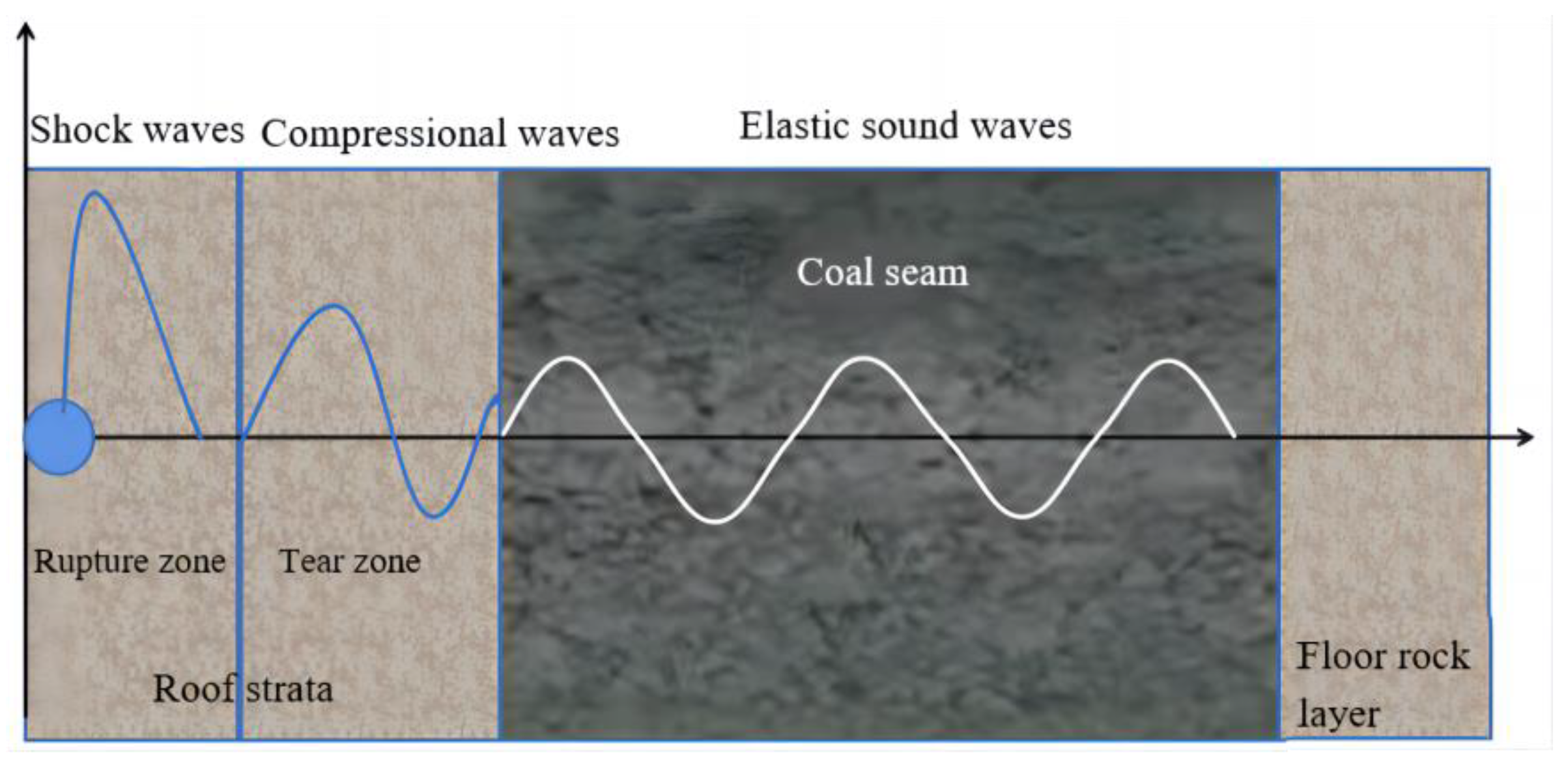
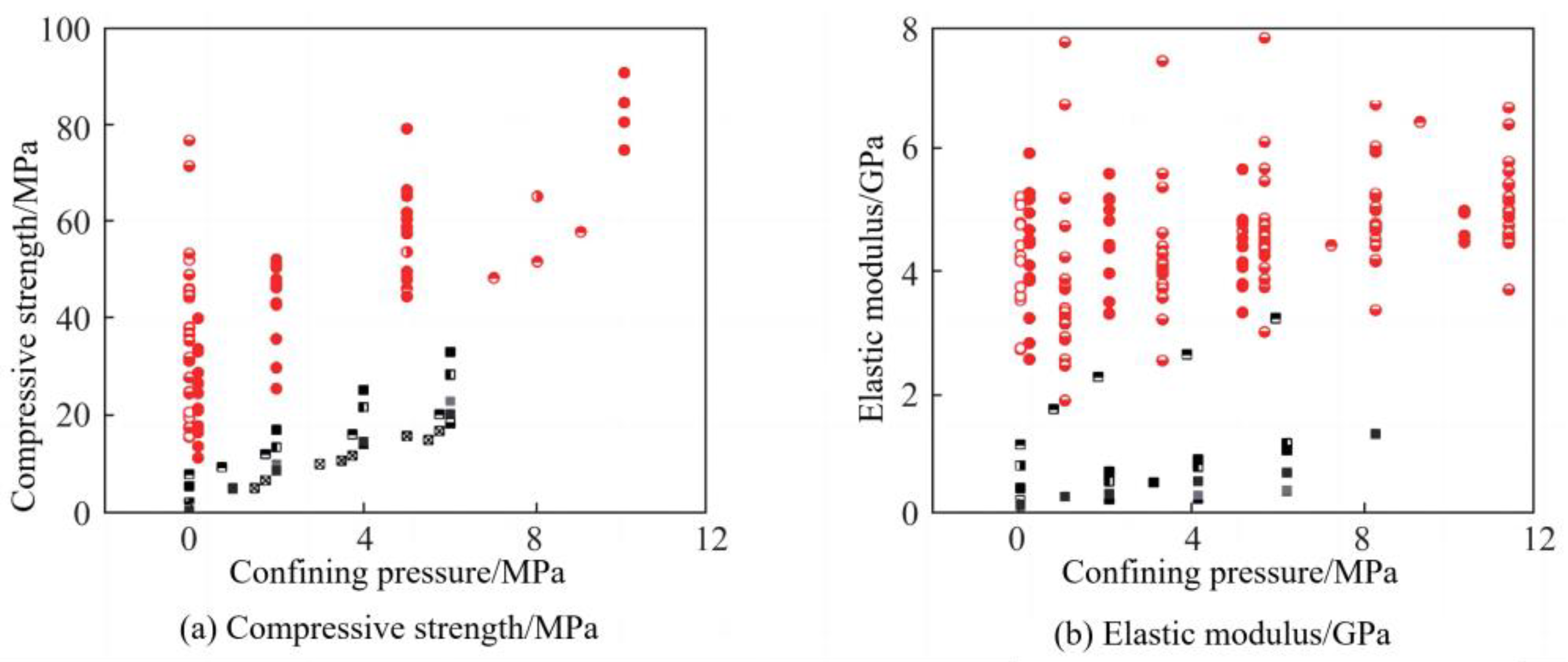
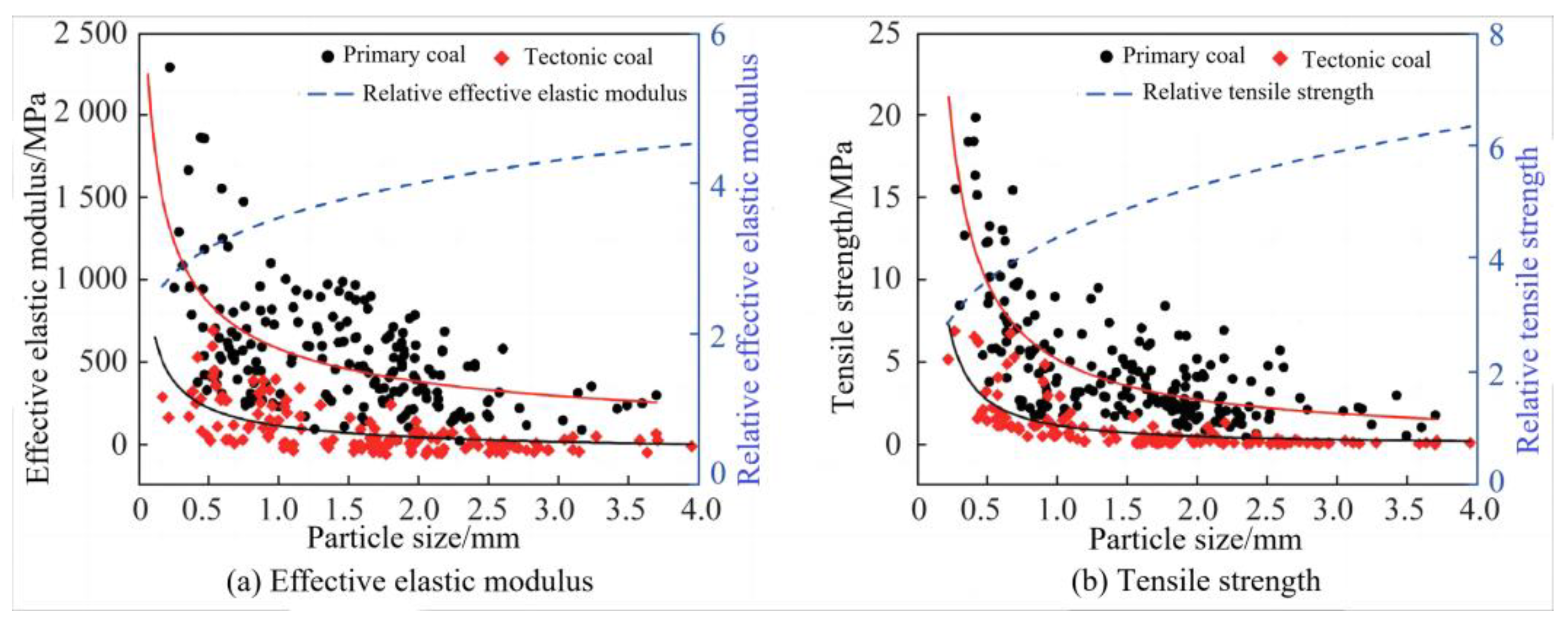

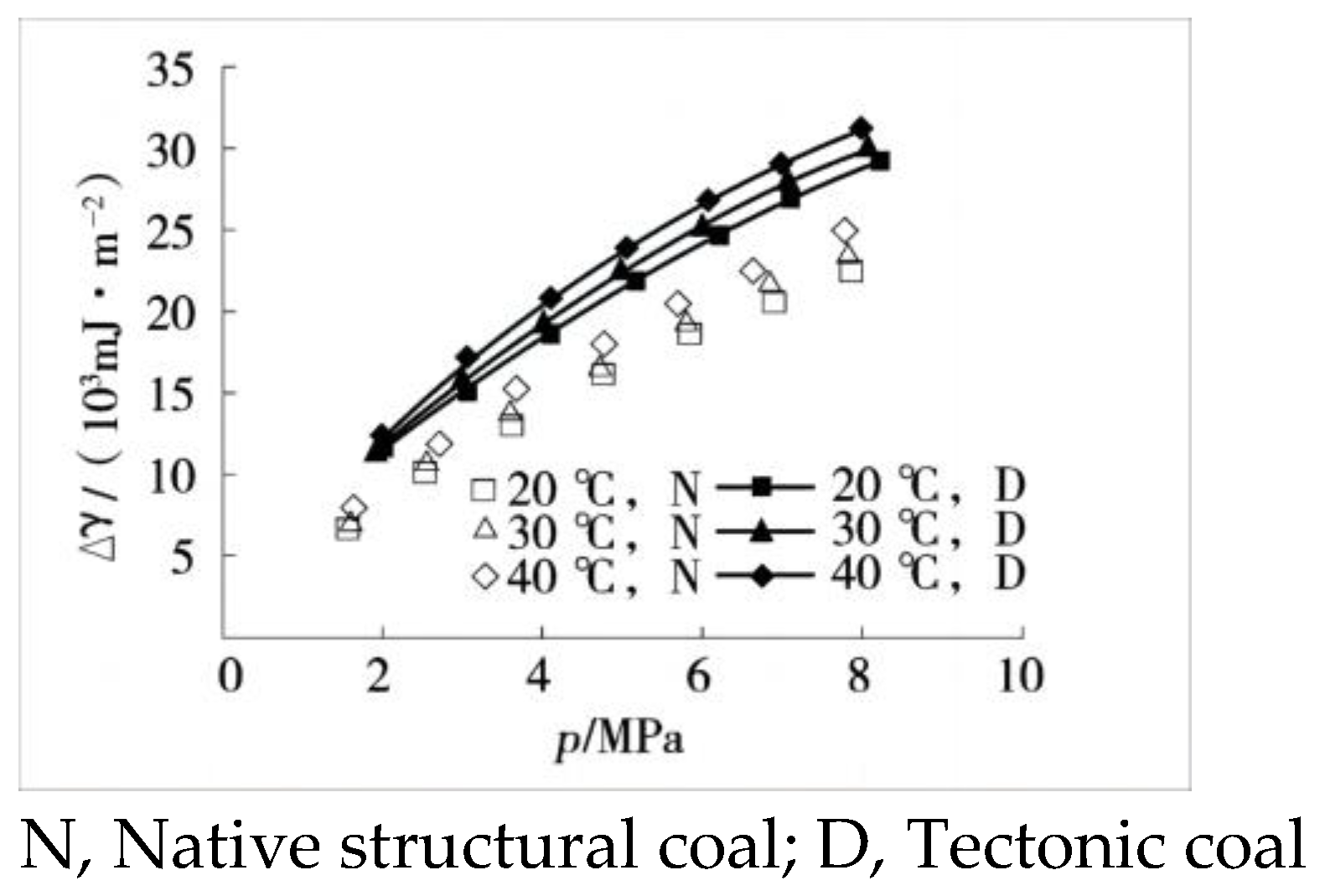
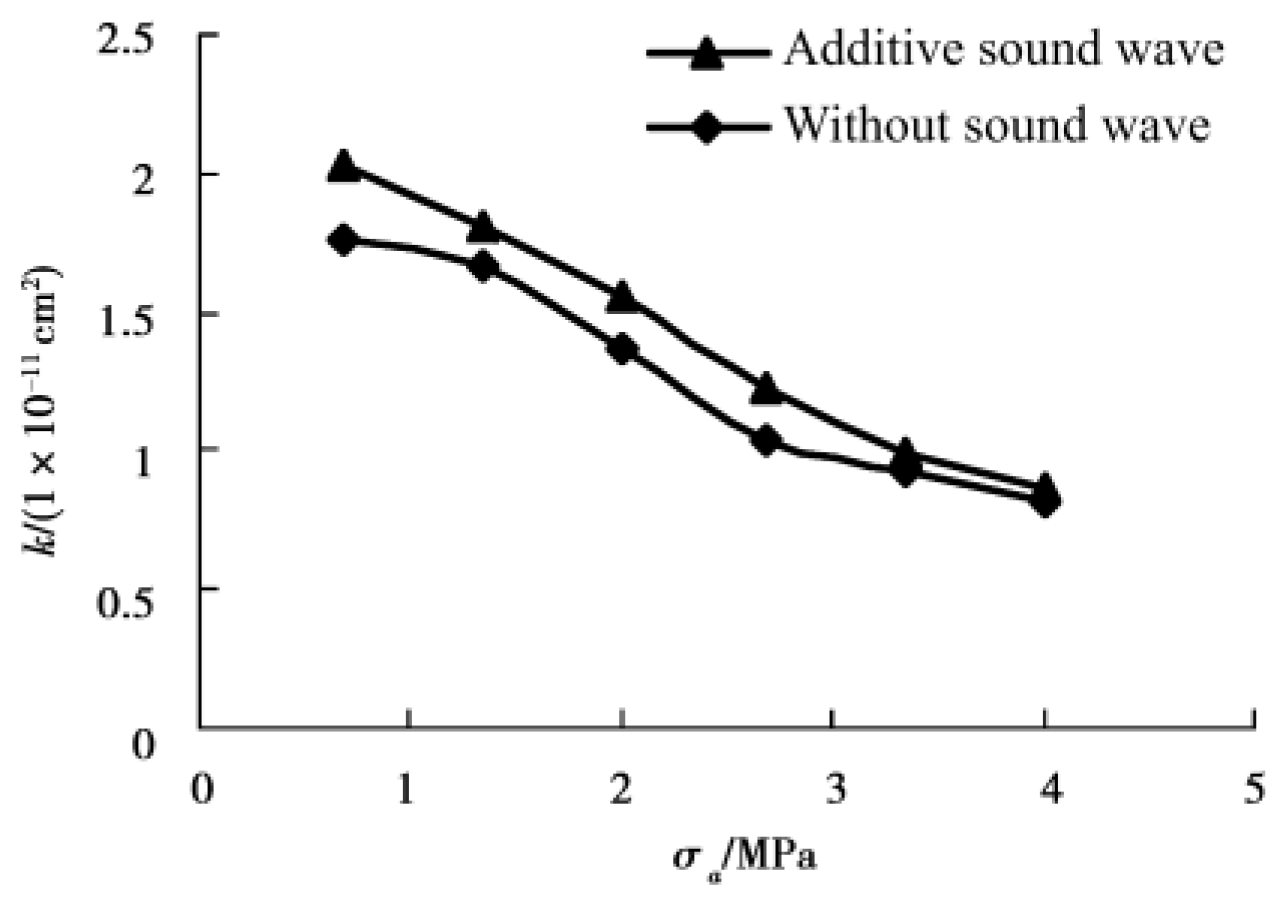

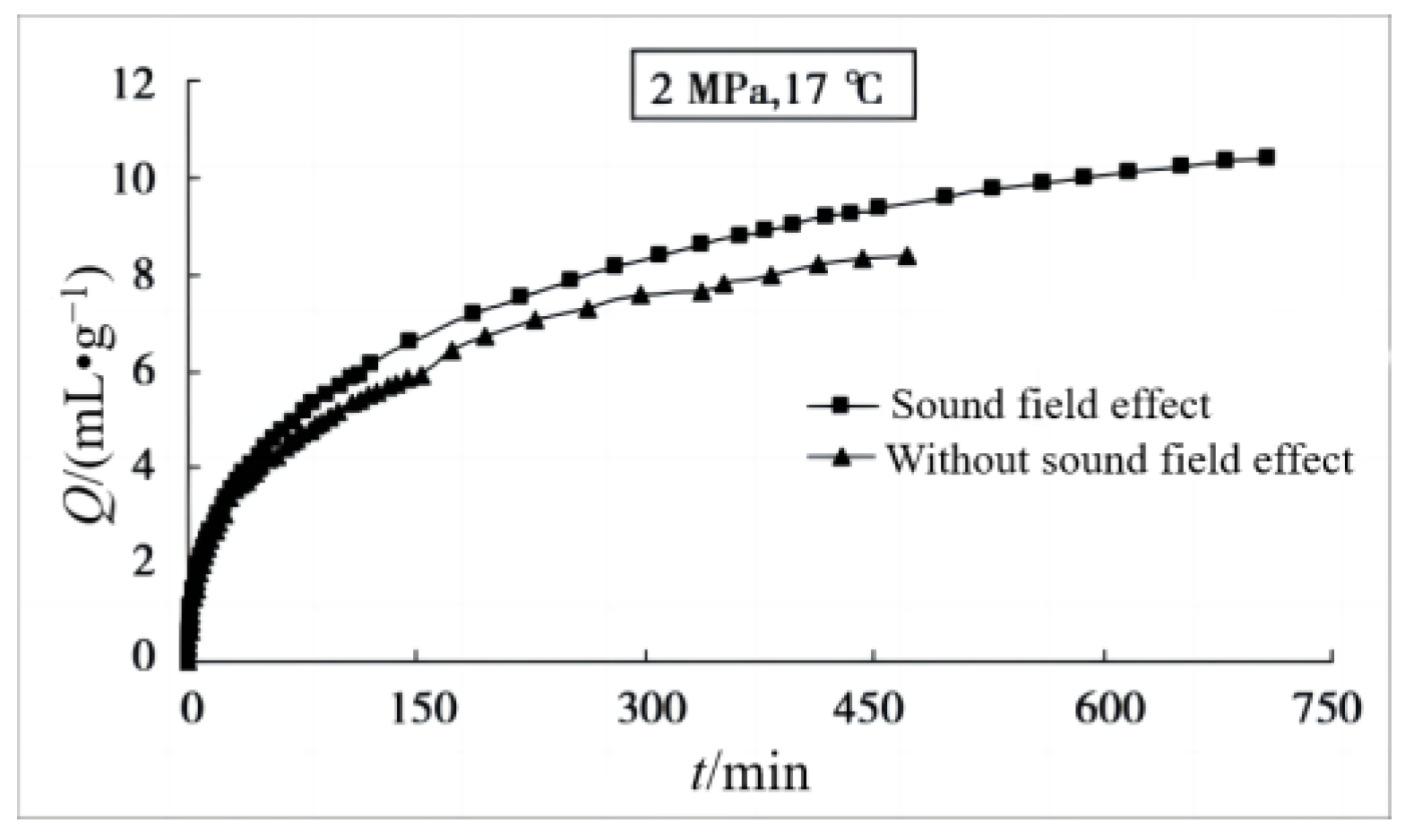


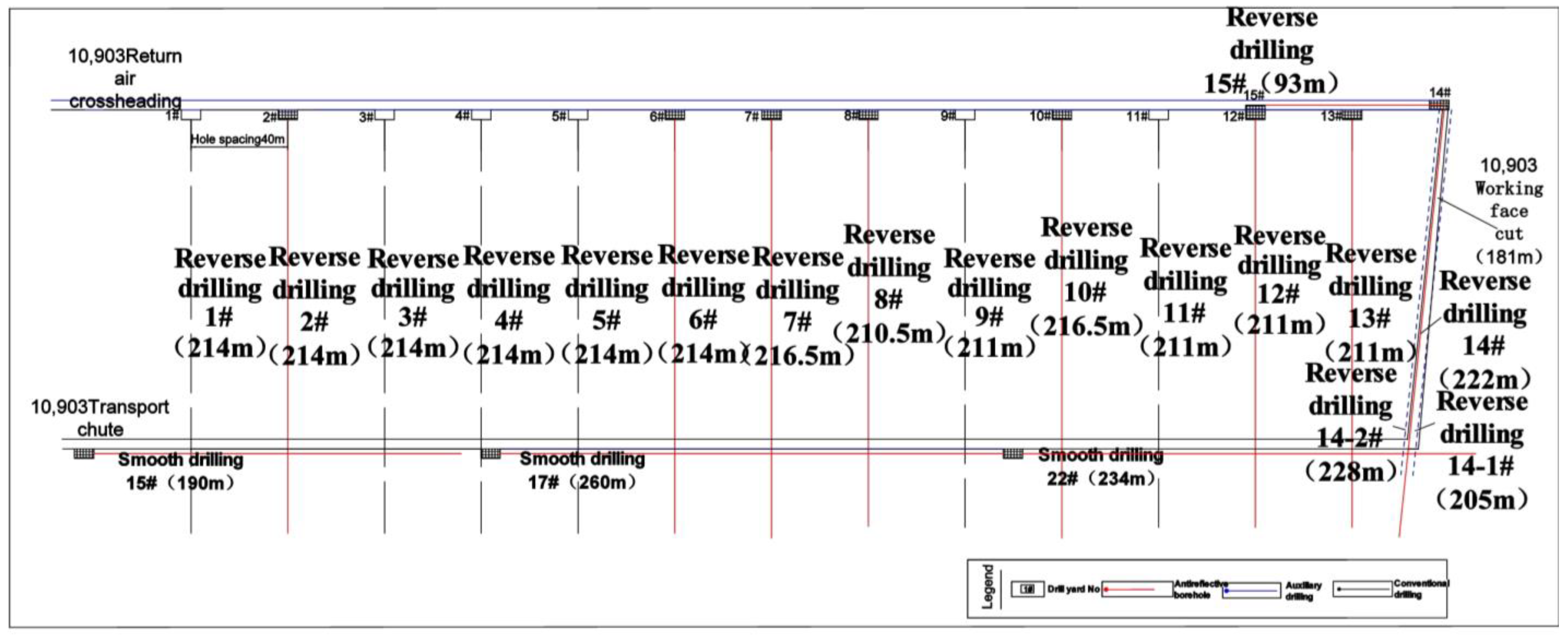


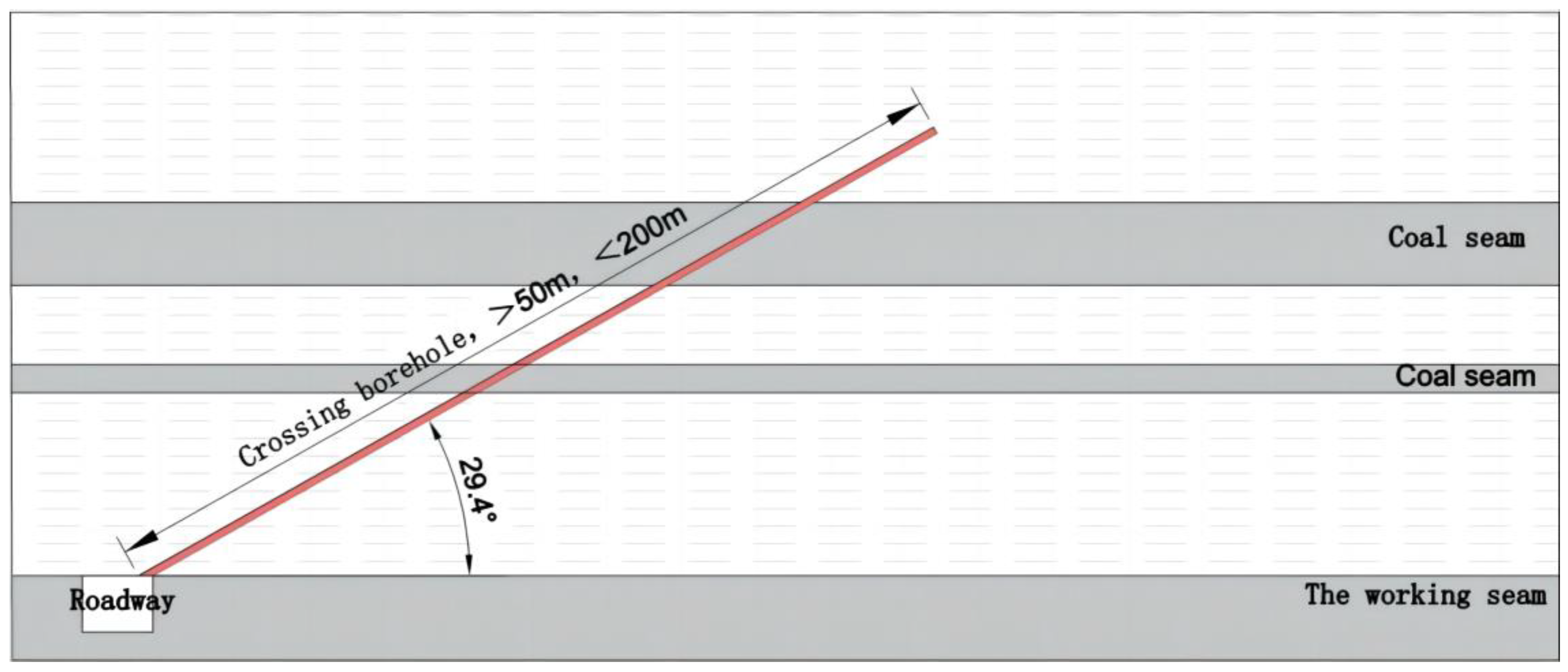

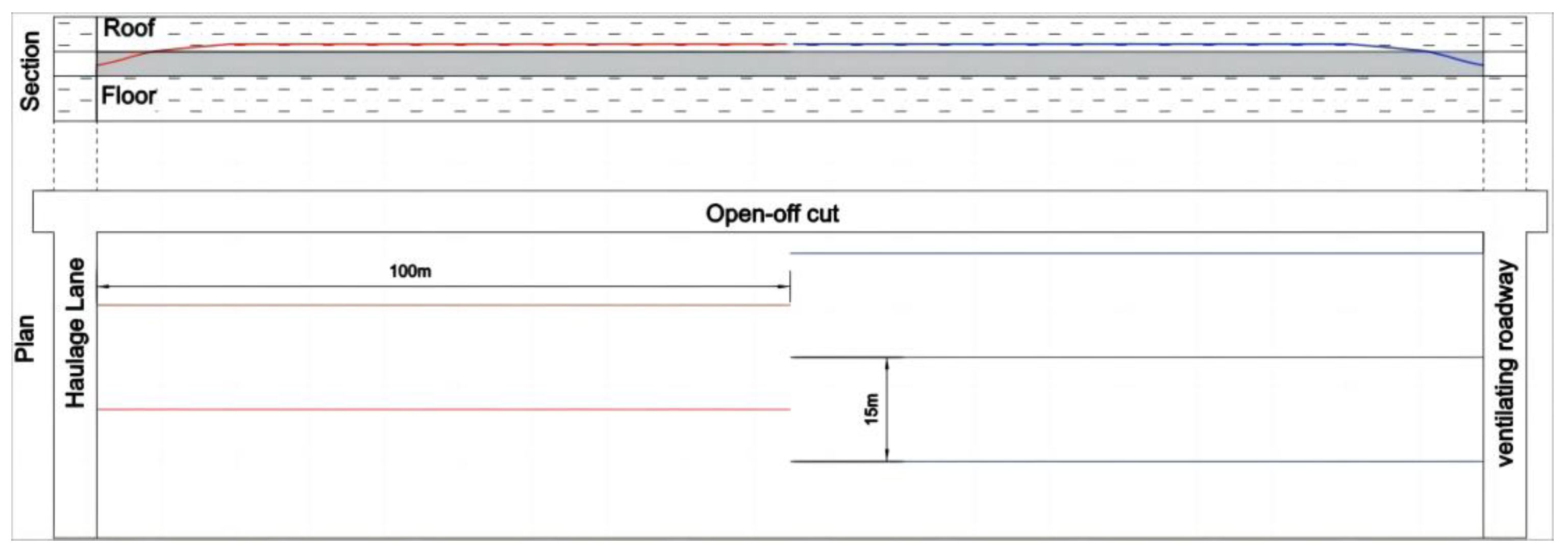
| Surface Energy (J/m2) | Modulus of Elasticity (GPa) | |||||||||||
|---|---|---|---|---|---|---|---|---|---|---|---|---|
| 0.2 | 0.5 | 0.8 | ||||||||||
| Stress Value (kPa) | Pressure Level (dB) | Sound Intensity (kW/m2) | Sound Intensity Level (dB) | Stress Value (kPa) | Pressure Level (dB) | Sound Intensity (kW/m2) | Sound Intensity Level (dB) | Stress Value (kPa) | Pressure Level (dB) | Sound Intensity (kW/m2) | Sound Intensity Level (dB) | |
| 0.01 | 11.3 | 175 | 2.46 × 10−2 | 134 | 17.8 | 179 | 6.1 × 10−2 | 138 | 22.6 | 181 | 9.82 × 10−2 | 140 |
| 0.02 | 16 | 178 | 4.92 × 10−2 | 137 | 25.2 | 182 | 0.122 | 141 | 31.9 | 184 | 0.196 | 143 |
| 0.03 | 19.5 | 180 | 7.31 × 10−2 | 139 | 30.9 | 184 | 0.184 | 143 | 39.1 | 186 | 0.294 | 145 |
| Surface Energy (J/m2) | Modulus of Elasticity (GPa) | |||||||||||
|---|---|---|---|---|---|---|---|---|---|---|---|---|
| 0.2 | 0.5 | 0.8 | ||||||||||
| Stress Value (kPa) | Pressure Level (dB) | Sound Intensity (kW/m2) | Sound Intensity Level (dB) | Stress Value (kPa) | Pressure Level (dB) | Sound Intensity (kW/m2) | Sound Intensity Level (dB) | Stress Value (kPa) | Pressure Level (dB) | Sound Intensity (kW/m2) | Sound Intensity Level (dB) | |
| 0.01 | 36 | 185 | 0.249 | 144 | 56 | 189 | 0.6 | 148 | 70 | 191 | 0.942 | 150 |
| 0.02 | 50 | 188 | 0.48 | 147 | 80 | 192 | 1.23 | 151 | 100 | 194 | 1.92 | 153 |
| 0.03 | 62 | 190 | 0.739 | 149 | 98 | 194 | 1.85 | 153 | 124 | 196 | 2.96 | 155 |
| Frequency of sound wave f (Hz) | 10 | 50 | 100 | 200 | 500 | 1000 | 20,000 |
| Attenuation coefficient α (m−1) | 0.00268 | 0.013 | 0.025 | 0.046 | 0.134 | 0.28 | 6.85 |
| Distance | Frequency | |
|---|---|---|
| 100 Hz | 200 Hz | |
| 10 m | 30.9 (165 dB) | 12.8 (164 dB) |
| 20 m | 25.8 (164 dB) | 11.5 (161 dB) |
| 30 m | 10.8 (160 dB) | 5.9 (158 dB) |
| 40 m | 7.3 (159 dB) | 3.2 (155 dB) |
| 50 m | 5.1 (157 dB) | 1.8 (153 dB) |
Disclaimer/Publisher’s Note: The statements, opinions and data contained in all publications are solely those of the individual author(s) and contributor(s) and not of MDPI and/or the editor(s). MDPI and/or the editor(s) disclaim responsibility for any injury to people or property resulting from any ideas, methods, instructions or products referred to in the content. |
© 2023 by the authors. Licensee MDPI, Basel, Switzerland. This article is an open access article distributed under the terms and conditions of the Creative Commons Attribution (CC BY) license (https://creativecommons.org/licenses/by/4.0/).
Share and Cite
Li, W.; Zhang, Y.; Wang, D.; Chen, C.; Li, Y.; Zhao, Y.; Zhang, S.; Ren, J.; Qin, Y. Theoretical Basis and Technical Method of Permeability Enhancement of Tectonic Coal Seam by High Intensity Acoustic Wave In Situ. Processes 2023, 11, 2372. https://doi.org/10.3390/pr11082372
Li W, Zhang Y, Wang D, Chen C, Li Y, Zhao Y, Zhang S, Ren J, Qin Y. Theoretical Basis and Technical Method of Permeability Enhancement of Tectonic Coal Seam by High Intensity Acoustic Wave In Situ. Processes. 2023; 11(8):2372. https://doi.org/10.3390/pr11082372
Chicago/Turabian StyleLi, Weidong, Yongmin Zhang, Dalong Wang, Cunqiang Chen, Yongyuan Li, Youzhi Zhao, Shuo Zhang, Jing Ren, and Yong Qin. 2023. "Theoretical Basis and Technical Method of Permeability Enhancement of Tectonic Coal Seam by High Intensity Acoustic Wave In Situ" Processes 11, no. 8: 2372. https://doi.org/10.3390/pr11082372





